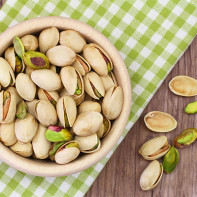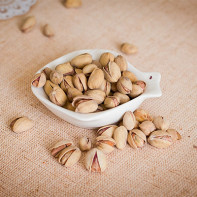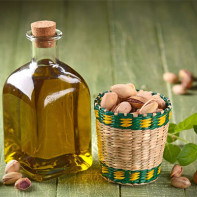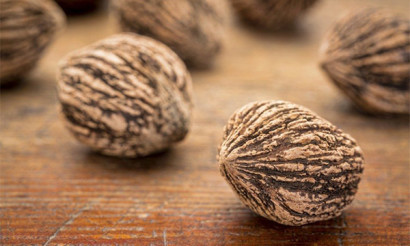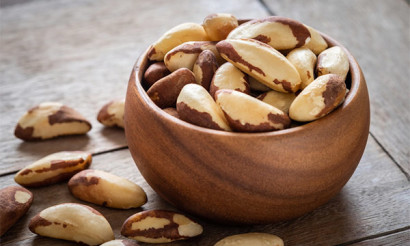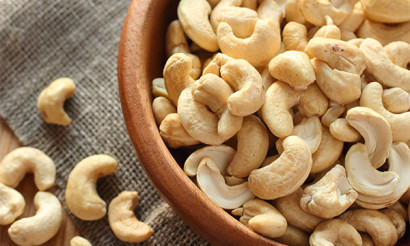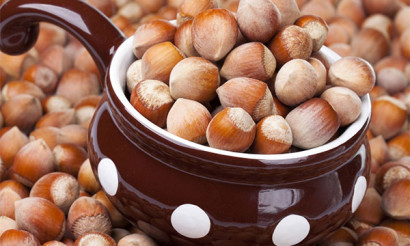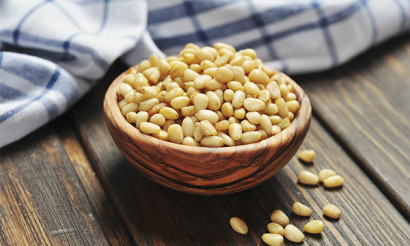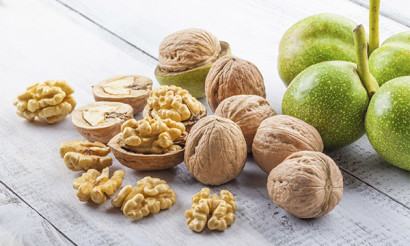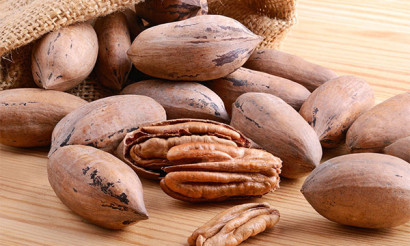Pistachio nuts: useful properties and contraindications
There are quite a few products that help people feel more awake and cheerful. For example, these are pistachios, dubbed "happy nuts" because of the special properties that have a positive effect on the body. Nuts are quite small, have a grayish color, a greenish core, covered with a hard shell and have a unique taste.
- How and where pistachios grow
- Types
- Composition and calories
- How to use pistachios
- General benefits
- For Women
- For Men
- Pregnancy
- Breastfeeding
- For children
- Slimming down
- Can salted and roasted pistachios be useful?
- Pistachio Oil: Properties and Uses
- Pistachio Medically
- Diabetes
- For pancreatitis
- For gastritis
- In constipation
- For gout
- For the Liver
- Recipes of folk medicine based on pistachios
- Decoction for a weakened body
- For constipation and normalization of digestion
- Skin diseases
- For impotence
- Prevention of atherosclerosis and diabetes
- In case of kidney cramps
- Pistachio in cosmetology
- Cooking with Pistachios
- Hazards and contraindications.
- How to choose and store pistachios
- How to Eat Pistachios
- How much can be eaten per day?
- Allow to eat at night.
- How to open closed pistachios.
- Can I Eat Pistachios During Lent?
- How to roast pistachios.
- Can we give pistachios to animals?
- Interesting Facts about Pistachios
How and where pistachios grow
The pistachio is the closest relative of the cashew and grows in areas with higher air temperatures and likes arid climates. The plant is common in the northwestern part of the African continent, the Middle East, Syria, and Iran. Pistachios can also be found in Central America and in parts of Tajikistan, Turkmenistan, Uzbekistan and Kyrgyzstan. Nuts are grown in western and southern Europe, as well as in Turkey. In the wild it is propagated by seed or shoots but in an artificial environment pistachios are propagated by cuttings.

The trees thrive in calcium-rich soils that stimulate their growth. Plant height on average does not exceed 6 m, they have a dense and rather low crown. Flowers begin to appear in mid-spring and the crop can be harvested in early fall. Pistachios are a long-lived crop; trees can live up to 400 years. For example, in the city of Samarkand there is a tree that is over 500 years old. Although pistachios prefer heat and light, they can withstand quite low temperatures down to -25°C. In the days when they had to be harvested by hand, they were harvested at night. The reason for this was that the sun released toxic essential oils from the leaves. Today, of course, these problems do not prevent the harvesting of fruits during the day, because there are special machines for this purpose.
Types
There are about 20 species of pistachios, here are some of them:
- Real. One of the most popular types of pistachios. It has delicious large fruits and good yields. Habitat - Central Asia, Afghanistan, Iran, Caucasus, Mediterranean, USA.
- Tuberous. It is also called wild pistachio, kev and turpentine tree, or false bacau. Habitat - Crimea, Caucasus, Transcaucasia, Asia Minor. The tree normally tolerates low temperatures, but prefers hot climates.
- Chinese. Habitat is in northern China. Frost-resistant species often used as rootstock for capricious pistachios.
- American. Also called the Mexican. Occurs in the United States and Mexico.
- Mastic. Another name is mastic. The place of growth is in the Mediterranean. Used for its resin, which is widely used in traditional medicine and varnish production.
- Turpentine. Place of growth - the Mediterranean. Its small fruits are red when mature and covered with black coloring. The plant is used to produce turpentine, and its kernels are used to make various dishes.
Composition and calories
Pistachios are very nutritious and contain many important vitamins and minerals that support the health of the entire body, from the skin to the intestines. It is worth noting, however, that pistachios are quite caloric and can add a few extra pounds, so you need to be careful when consuming them, especially if you are worried about your weight. Even so, the benefits of the product far outweigh any potential adverse effects.
100 grams of the product contains:
- Calories - 572.
- Protein - 21.1 g.
- Fats - 45.8 g.
- Carbohydrates - 18 g.
- Fiber - 10,3 gr.
- Vitamin A - 260 IU.
- Vitamin E - 1,8 mg.
- Vitamin K - 3,2 mg.
- Thiamine - 0.8 mg.
- Vitamin B6 - 1,5 mg.
- Choline - 70 mg.
- Calcium - 110 mg.
- Iron - 4 mg.
- Phosphorus - 480 mg.
- Magnesium - 120 mg.
- Potassium - 1040 mg.
- Zinc - 2,5 mg.
- Copper - 1,5 mg.
- Manganese - 1,3 mg.
- Selenium - 9 mg.
What are the health benefits of pistachios
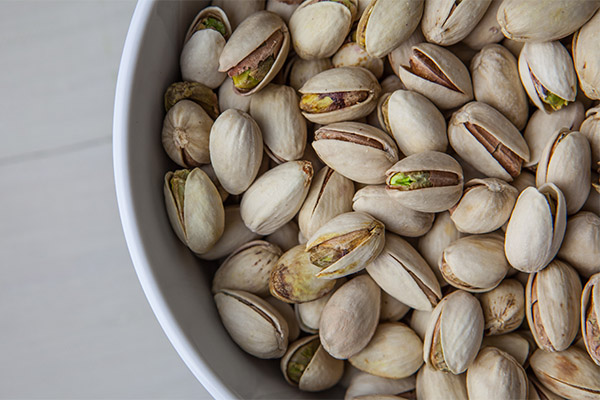
General benefits
- Maintain the health of the blood vessels. There can be many reasons for high blood pressure. One of these is the loss of elasticity of blood vessels. Pistachios help control blood pressure by reducing the stiffness of blood vessels, allowing them to expand better and be more elastic. Pistachios contain the amino acid L-arginine, which helps to vasodilate blood vessels, as well as other substances that strengthen their health. Pistachios reduce the risk of atherosclerosis.
- Stabilize blood glucose levels. Although pistachios contain a moderate amount of carbohydrates, it is enough to affect glucose absorption. The product contains quite a lot of protein, fat and fiber, substances that slow the process of glucose absorption and the body's response to insulin. In addition, pistachios are full of antioxidants that support the pancreatic cells that produce insulin.
- Enhance the health of the heart. Not everyone knows this, but fats can support heart health, especially when it comes to unsaturated fats. Pistachios are rich in both monounsaturated and polyunsaturated fats, which help regulate LDL cholesterol levels and improve overall health. The presence of plant sterols and numerous antioxidants in the product also help support heart health.
- Support eye health. Age-related yellow spot degeneration affects millions of people worldwide and in some cases leads to total blindness. Lutein and zeaxanthin are carotenoid antioxidants that can significantly reduce the risk of this disease. Pistachios are rich in these antioxidants, so eating them regularly will help keep your eyes healthy for as long as possible.
- Help with bowel function. Pistachios are rich in soluble fiber, which helps the gut do its job, which in turn reduces risk factors for diseases such as cancer, peptic ulcers and others.
- Maintain healthy skin. A very common cause of early skin aging is overexposure to ultraviolet radiation. Pistachios contain vitamin E, which is one of the best for keeping skin healthy. Vitamin E reflects some of the ultraviolet radiation, helping to reduce skin damage as well.
- Supports the health of the nervous system. Pistachios are rich in vitamin B6, which helps the body maintain protein metabolism. Protein metabolism affects the formation of the myelin sheath, which interacts with nerve fibers. This sheath ensures the passage of electrical impulses along the nerves.
- Increase sex drive. Sometimes the reason for a low sex drive can be a lack of fat in the diet. Testosterone is the main determinant of sex drive, and there must be sufficient fat and cholesterol in the body to produce it. It is worth noting that selenium and zinc, substances that are also found in pistachios, help produce testosterone.
- Reduce the risk of developing skin cancer. In many cases, the cause of skin cancer is excessive exposure to the sun, which provokes mutations in skin cells. Pistachios contain vitamin E, which blocks harmful UV rays from entering the skin. It also helps protect cell membranes from UV exposure and dehydration, promoting cell health.
- Maintain Hair Health. The body needs a steady supply of vitamins and minerals to keep hair healthy. Vitamin E and biotin are considered most important. Pistachios contain both of these nutrients as well as the amino acid L-arginine, which improves circulation, including in the scalp. A common cause of hair loss is poor blood flow to the hair follicles, which can cause nutrients to not reach the hair.
- Rich in antioxidants. Antioxidants play a very important role in human life as they protect the body from the adverse substances it interacts with on a daily basis. Pistachios are an excellent natural source of antioxidants along with other phytochemicals such as vitamin E or carotenes, which help in the fight against free radicals and the side effects associated with them. By removing toxic oxygen-free radicals from the body, pistachios reduce the risk of cancer and also strengthen the immune system.
For women.
Although pistachio nuts have a lot of calories, they are recommended for women who want to get rid of extra pounds. Nuts also strengthen the heart muscle and normalize the circulatory system, which helps to rejuvenate the body. Pistachios support healthy nails and hair and even smooth out shallow wrinkles. Pistachio oil has anti-inflammatory, wound-healing and whitening properties. It is used in the field of cosmetology and helps remove age spots, freckles and fights wrinkles.
For men
Many experts say that pistachios should be part of every man's daily diet. The main reason is that this product has a beneficial effect on male strength. The decrease of hormones in the body already at a young age leads to the sexual system malfunction. The reasons for this condition can vary, from a sedentary lifestyle to an unhealthy diet. Often this leads to a decrease in sex drive, and few people dare to consult a specialist on this issue, and is self-medicated. Of course, pistachios are not a cure-all, and they are not able to fully solve this problem, but they will help restore male potency, have a beneficial effect on potency and sexual activity.
It is also important to note that nuts improve the quality of sperm cells, increasing their vitality, so the chances of potential paternity will increase significantly.
When pregnant
Pistachios are useful for the future mother, because they fill her body with iron and enrich it with calcium. Raw fruits are considered to be the most useful, as they most effectively improve the health indicators of the mother and child.
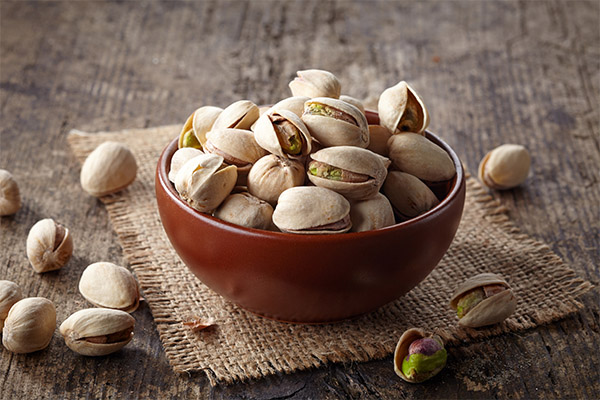
Another advantage of eating pistachios during pregnancy is that the product helps to reduce the manifestation of toxicity, which can cause serious discomfort to a woman. Also, pistachios ease the general state of the body and support the normal functioning of the liver. The only thing to pay attention to is the high caloric content of the product, which can affect the body weight. During pregnancy, you can eat up to 15 nuts a day.
When breastfeeding
There is no definite answer to the question - whether it is allowed to eat pistachios while breastfeeding. Some say that this product has a beneficial effect on breast milk, as well as strengthens and tones the body. Others say that pistachios can cause allergies, so they should not be consumed during the postpartum period. In any case, you must remember that the stomach of a newborn is not yet adapted to serious food and is not able to absorb some substances, for which reason and manifest allergic reactions. As a rule, in such cases, the child has a rash on the cheeks.
At the same time, experts advise not to refuse pistachios altogether, the main thing is to limit their consumption until the child is 7-8 months old. At this age a child's body will be able to properly assimilate this product. You should start with small portions. The product should be introduced in stages, with careful monitoring of the child's reaction. In case of rash or redness - you need to exclude pistachios from your menu and consult a doctor about this.
For kids
Pistachios are also useful for children, but only if the measure of consumption is observed, taking into account the age of the child. The most appropriate time to include nuts in a child's diet is at age 3. By this time the organs responsible for digestion will already contain enzymes that are designed to digest nuts.
The first meal should be given no more than a quarter of a nut, and it is better that the product is an ingredient in some dessert. The product should be consumed before dinner, so that in case of symptoms you can notice them. If even mild side effects occur, a specialist should be consulted. If the child is prone to allergies, it is not recommended to accustom him to pistachios until he is 5 years old.
For weight loss.
Although pistachios are rich in vegetable fats, most of them are unsaturated. At the same time, they contain just as much protein and fiber. This product has a beneficial effect on the body without causing insulin responses or converting excess calories into subcutaneous fat. Pistachios have a low glycemic index.
Pistachio nuts are not a bad source of complex carbohydrates, which the body needs for recovery, especially during a grueling diet. Complex carbohydrates tend to be broken down for quite a long time, so they keep you full for much longer, eliminating hunger attacks throughout the day. Pistachios are an excellent alternative to liver, chocolate and sunflower seeds, that is, those foods that often become the most attractive during a strict fast. Nuts are recommended for anyone on a strict diet. They will allow you to endure a meager menu for much longer, as well as saturate you with energy and protect you from depressive states.
Are salted and roasted pistachios useful?
The level of usefulness of pistachios depends largely on the type in which they are consumed, the most useful are considered fresh and unprocessed nuts. Salted and roasted pistachios are more tasty but less healthy. In fact, any processing of the product will remove some of its health benefits. For example, if the product contains a lot of salt, it can have a negative effect on blood pressure. Nausea and dizziness can occur if consumed in excess. Roasting reduces the availability of useful amino acids and fatty acids, so it is recommended to eat raw nuts, not roasted.
Pistachio oil: properties and uses
Pistachio oil is one of the most useful vegetable oils that exist. The product is not only rich in useful amino acids, but also has a very strong nutty flavor and outstanding softening properties.
Pistachio oil contributes to overall health and is especially good for the skin because it can help retain the necessary amount of moisture in the skin, preventing it from drying out. Pistachio oil is not only used in the culinary field, but also in the pharmaceutical and cosmetic industries, as well as in aroma and massage therapy due to its pleasant, intense and relaxing effect.
Pistachios in medicine
Pistachios are also used in the field of medicine. For example, the processed fruit can be consumed in case of digestive disorders or infusions can be made from them to help avoid infection from snake bites. Decoctions also help get rid of vomiting, asthenia, GI diseases and anemia. Pistachios have an anti-cough effect, so they can help with bronchitis.
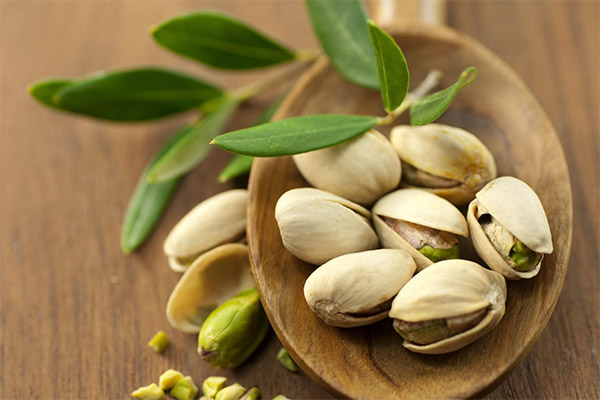
For diabetes.
Regular consumption of pistachios greatly reduces the risk of diabetes and its progression. The product is rich in proteins, fiber and monounsaturated fats, which help to remove toxins from the body, purify the blood and thus prevent the onset of diabetes.
People who already suffer from this disease (especially in the initial stages), it is recommended to eat up to one handful of pistachios per day. Already in the short term you can feel an improvement in health, and the disease will almost cease to remind of itself. Naturally, pistachios will not cure diabetes completely, but they will play an important role in a complex with other effective means.
Important: The glycemic index of pistachios is 15 units.
In pancreatitis
Include pistachios in your menu with pancreatitis can be only in remission, which should last at least 6 months. Beginning with 6 months you can slowly add pistachios to your diet, it is recommended to eat 2 tablespoons 2-3 times a week. At the first stage it is necessary to monitor the reaction of the body to the product.
With pancreatitis, only unsalted nuts are allowed to eat. During the exacerbation of pancreatitis it is strictly forbidden to eat pistachios, and even in case of a slight weakening of symptoms. It should be remembered that this product can provoke irritation of the mucous membranes, so the effect of therapeutic diet and drug therapy will be wiped out.
It is forbidden to eat pistachios in large quantities, because they contain a lot of fiber, which stimulates intestinal peristalsis and speeds up metabolic processes. In the case of pancreatitis, much depends on the patient's condition and the peculiarities of the disease. If the disease has been in remission for a long time, it is allowed to loosen restrictions and include pistachios in your diet, but it is important not to abuse them. It is highly recommended to crush the nuts, as this will facilitate the work of the digestive tract.
In case of gastritis.
Because of their excessively tough consistency, as well as their difficult digestibility, pistachios are considered an unacceptable food for gastritis. Indeed, the nuts can damage the inflamed mucous membrane of the stomach, but this only indicates that the product should not be consumed in its whole form. In the case of pistachios served chopped or pureed, you can eat them. To process the product, a blender or even a regular coffee grinder will do. The fine crumbs obtained by pounding the nuts are quite suitable for consumption in case of gastritis.
It is important to note, however, that there are still some restrictions on eating this product when the stomach is inflamed. It is forbidden to eat pistachios on an empty stomach, and it is important to observe moderation. In general, with gastritis, it is allowed to eat pistachios, but only in ground form and in the absence of exacerbation of the disease.
With constipation
Pistachios are allowed to eat with constipation, but it is recommended to focus not on the nuts, but on the oil from them. The oil that is obtained from the fruit can help get rid of constipation and other gastrointestinal diseases. Pistachio oil will contribute to a more effective removal of toxins from the body.
If you have gout.
Pistachios are not recommended to consume with gout. Nuts contain purines, and even they are not the main reason for prohibiting the use of this product. Pistachios can provoke edema by retaining fluid in the body, especially if salted nuts are involved. They can cause swelling of the affected joints and impair kidney function, so that uric acid cannot leave the body normally.
For the liver
Pistachios have a beneficial effect on the liver, as they normalize its work and clean the bile ducts from blockages. Even a small amount of nuts can get rid of liver cramps.
Recipes of folk medicine based on pistachios
Decoction for a weakened organism
- Pistachio fruits (20 g) pour boiling water (1 cup) and put to boil on low heat.
- After boiling, leave it to boil for a few minutes more.
- Strain the decoction.
- Drink the drink (pistachios can be eaten) in 2-3 drinks for one day. Do it half an hour before a meal.
For constipation, to normalize digestion
Every morning for 30 days to take 1-2 tsp. pistachio oil (on an empty stomach).
For diseases of the skin
Many people suffer from excessive peeling of the skin. To do this, 3-4 times a day to lubricate the problem areas of the skin with pistachio oil. It is necessary to treat until recovery.
To increase impotence
For 25-30 days every day to consume pistachios (kind - real). Daily rate of consumption - 100 grams.
The prevention of atherosclerosis and diabetes
Eat a daily portion of pistachios. Daily rate of consumption is 50 g.
In case of kidney cramps.
Nuts will help in this case to relieve renal colic. The daily rate of consumption is 1 handful of nuts.
Pistachios in cosmetology
In the field of cosmetology, pistachio oil is widely used. It contains phytosterols and vitamin E - substances that have moisturizing and softening effects. This product is often present in various massage mixtures. It helps to improve the sliding properties and is therefore excellent for massage procedures. The oil tends to spread easily on the skin and is quickly absorbed, making the skin smooth. Phytosterols stimulate skin regeneration processes and strengthen its barrier functions. They affect the synthesis of collagen and restore elasticity.

The oil has anti-inflammatory properties, heals and soothes irritated skin. It can also be found in various anti-aging products. The oil is used to care for dry skin and dry hair.
Dry skin mask
- Add one drop each of rose, chamomile and sandalwood and mix into a pistachio oil (1 tbsp.).
- Masque to put on a napkin and apply to problem areas.
- Wait 20 minutes. Wash your face.
Mask for shiny and silky hair
- Add pistachio oil (1 tbsp.) and olive oil (1 tbsp.) to the egg yolk.
- Spread the mixture over the entire length of the hair and wrap the head.
- Wait for 2 hours.
- Rinse with lemon water or use a decoction of chamomile.
Cooking with pistachios
Pistachios can be used as a snack on their own or as part of a dish. For example, they are indispensable in the manufacture of candies, cookies, chocolate. Oriental sweets such as halva, marshmallows and gingerbread can also be made without these nuts.
Pistachios go well with meat dishes and pates. In powdered form this product is used together with fish. In some national cuisines poultry is stuffed with nuts. They can be part of sauces for both salty and sweet dishes. Quite popular is pistachio ice cream, which has a greenish hue and a nutty taste. In addition, some beer lovers use pistachio fruit as a standalone snack to their drink.
Harm and contraindications
Contraindications depend on the composition of the product, the peculiarities of its production and storage:
- Excessive consumption of nuts can negatively affect the kidneys.
- There is a risk of contracting aflatoxin. This is a carcinogen that weakens the immune system and provokes the development of liver cancer.
- Salty pistachios can cause swelling.
- Pistachios can carry Salmonella, a dangerous food bacteria.
In addition, this product can cause allergies.
Symptoms of pistachio allergy:
- Coughing or sneezing;
- Swelling of the mucosa of the respiratory tract or tongue;
- A tingling sensation in the mouth;
- itching.
It is important to note that children are very sensitive to allergens, so the manifestation of their allergic reactions to the product can be in a particularly acute form. Pistachios can cause choking, runny nose, and skin rashes. Some children may experience diarrhea, nausea, and fever.
How to choose and store pistachios
When choosing pistachios, you should pay attention to the shell of the nuts. The shell should be creamy or white (a little dirty). There should not be any cracks or spots. Pistachio kernels should be green in color. No offensive smells, such as mold, should emanate from the product. It is also worth paying attention to the shelf life of the product, it is usually specified on the packaging.

Nuts should be stored separately from other products, so that they do not absorb extraneous odors. They should be kept in an airtight container. If we are talking about unsalted nuts, they can be stored in the refrigerator for about 3 months, in the freezer - up to 1 year.
How to eat pistachios correctly
Before eating pistachios, you should peel them from the shell and soak them in cool water for a few hours. This procedure will help remove the skin from the kernel or soften it considerably, making the nuts as healthy as possible and improving their digestibility.
How much can be eaten per day
The recommended daily rate is 30 g of pistachios, this is about 50 nuts.
Can I eat at night?
Pistachios are excellent as a bedtime snack, because they have the optimal amount of fat and calories to satisfy evening hunger.
How to open closed pistachios
You can open a pistachio that doesn't have a crack by using special tongs. If you do not have them, you can use pliers or a garlic crusher. The shell can also be cracked with a hammer. If there is even a small crack on the pistachio, it will be convenient to open it with a simple coin or a shell of an already cracked nut. To do this, you need to insert it into the crack and twist it so that the shell opens completely.
The pistachio can, of course, be opened with your hands, such as your fingernails, but this can damage them. You can also use industrial machines for splitting, soaking and drying. You can even use ice to split the shell.
Can pistachios be eaten during Lent?
Seeds and nuts are allowed during Lent, so pistachios can also be eaten.
How to roast pistachios
Pistachios should be sorted and the unfit nuts discarded. After that, you should:
- on a thick frying pan pour the nuts in a single layer;
- Cook the pistachios, stirring all the time (up to half an hour);
- pour the nuts onto a plate and let them cool.
Can we give pistachios to animals?
Pistachios are contraindicated for dogs, as they are toxic. You should not give them to your pet, otherwise the pet may develop urolithiasis. It is best not to feed cats with pistachios either, as it can provoke diarrhea, vomiting, or even pancreatitis.
Interesting facts about pistachios
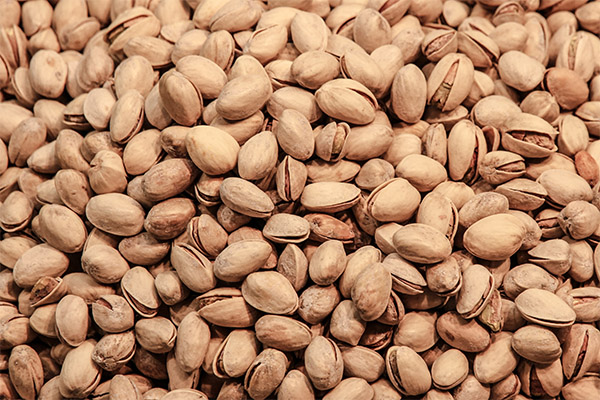
- A study conducted by the Pennsylvania State University revealed the fact that regular consumption of pistachios minimizes the effects of stress on the body.
- It's a fun fact that few people know about, that in fact, pistachios are not nuts. In fact, pistachios are seeds. The reason this product is classified as a nut is because they look like nuts and are also part of the cashew family. It is important to note, however, that the cashew family does not include only nuts, so referring the entire family to nuts is not entirely accurate.
- At one time, pistachios were considered a very valuable and nutritious food, especially to the taste of the Queen of Sheba. She declared it to be an exclusively royal food, so only the nobles were allowed to eat the nuts. In fact, the queen took pistachios so seriously that she even forbade commoners from growing them. But the Queen of Sheba was not the only one whose passion for pistachios has been recorded in history, for it is also known that the kings of Babylon revered the product. Pistachios were so prized in ancient Babylon that King Nebuchadnezzar even had the crop planted in the famous Hanging Gardens.
- Few people know that the natural color of pistachios is green, and that they are often dyed to make the nuts more attractive to the consumer.
- For centuries, people have consumed pistachios not only for their general health or for their taste, but also because chewing the resin of the pistachio tree whitens the teeth and freshens the breath.
- One of the many uses of pistachios in ancient times was in folk medicine, where they were widely used as part of folk remedies, which were intended to treat various ailments - from toothaches to sclerosis of the liver.
- Pistachios were a favorite food of early travelers and traders. They were usually taken with the ship by seafarers who traveled long distances, as they believed that the nuts had high nutritional value and a long shelf life.
«Important: All information on this site is provided for informational purposes only For educational purposes only. Please consult with a health care professional before using any of our recommendations. specialist before using any of the recommendations. Neither the editors nor the authors shall be held liable for any possible harm caused by materials."


